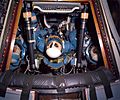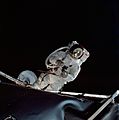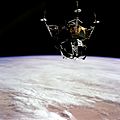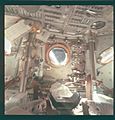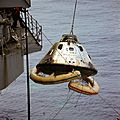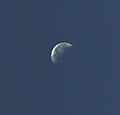Apollo 9 facts for kids
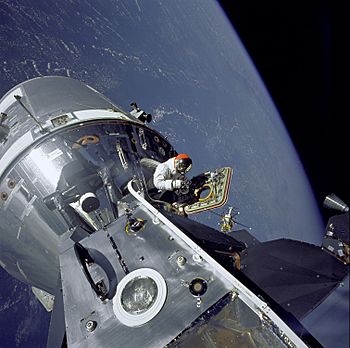
David Scott performs a standup EVA from Command Module Gumdrop, seen from docked Lunar Module Spider
|
|
| Mission type | Lunar Module test flight |
|---|---|
| Operator | NASA |
| Mission duration | 10 days, 1 hours, 54 seconds |
| Spacecraft properties | |
| Spacecraft |
|
| Manufacturer |
|
| Launch mass | 95,231 pounds (43,196 kg) |
| Landing mass | 11,094 pounds (5,032 kg) |
| Crew | |
| Crew size | 3 |
| Members |
|
| Callsign |
|
| EVAs | 1 |
| EVA duration | 77 minutes |
| Start of mission | |
| Launch date | March 3, 1969, 16:00:00 UTC |
| Rocket | Saturn V SA-504 |
| Launch site | Kennedy LC-39A |
| End of mission | |
| Recovered by | USS Guadalcanal |
| Decay date | October 23, 1981 (LM) |
| Landing date | March 13, 1969, 17:00:54 UTC |
| Landing site | North Atlantic Ocean 23°15′N 67°56′W / 23.250°N 67.933°W |
| Orbital parameters | |
| Reference system | Geocentric |
| Regime | Low Earth orbit |
| Perigee | 204 kilometers (127 mi) |
| Apogee | 497 kilometers (309 mi) |
| Inclination | 33.8 degrees |
| Period | 91.55 minutes |
| Epoch | March 5, 1969 |
| Docking with LM | |
| Docking date | March 3, 1969, 19:01:59 UTC |
| Undocking date | March 7, 1969, 12:39:06 UTC |
| Docking with LM Ascent Stage | |
| Docking date | March 7, 1969, 19:02:26 UTC |
| Undocking date | March 7, 1969, 21:22:45 UTC |
 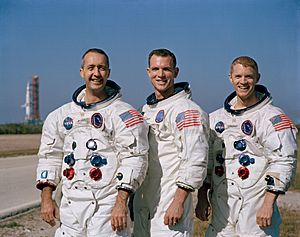 Left to right: McDivitt, Scott, Schweickart |
|
Apollo 9 was a very important space mission by NASA. It was part of the Apollo program, which aimed to land humans on the Moon. This mission was special because it was the first time the two main spacecraft for the Moon landing – the Command/Service Module (CSM) and the Lunar Module (LM) – flew together with a crew.
The crew members were Commander James A. McDivitt, Command Module Pilot David R. Scott, and Lunar Module Pilot Russell L. Schweickart. They launched into space on March 3, 1969. The main goal of Apollo 9 was to test how the LM would work in space. This included checking its engines, the life support backpacks astronauts would wear on the Moon, and how the two spacecraft could connect and disconnect in orbit.
Contents
Testing the Lunar Module in Space
Why Apollo 9 Was Important
Apollo 9 was a crucial step before astronauts could land on the Moon. Previous missions had tested parts of the Apollo spacecraft. But Apollo 9 was the first time the entire "Moon landing team" of spacecraft was put to the test. The crew needed to make sure everything worked perfectly.
The Crew and Their Spaceships
The three astronauts had special names for their spacecraft. The Command/Service Module (CSM) was called Gumdrop. This was where the astronauts lived for most of the mission. The Lunar Module (LM) was called Spider. This was the part designed to land on the Moon.
- James McDivitt was the mission commander. He was in charge of the entire flight.
- David Scott was the pilot of Gumdrop. He stayed in the CSM during the LM tests.
- Russell Schweickart was the pilot of Spider. He helped test the LM's systems.
Key Moments of the Mission
Launch and Orbit
Apollo 9 launched from Kennedy Space Center in Florida on March 3, 1969. A powerful Saturn V rocket carried the spacecraft into orbit around Earth. The mission lasted for 10 days, 1 hour, and 54 seconds.
Docking and Undocking Tests
One of the most important tests was practicing how Gumdrop and Spider would connect and disconnect. This is called docking. When astronauts went to the Moon, the LM would separate from the CSM, land, and then rejoin the CSM after exploring.
- On the first day, the crew successfully docked Gumdrop and Spider.
- Later in the mission, McDivitt and Schweickart entered Spider. They separated Spider from Gumdrop and flew it on its own.
- They tested Spider's engines, which were vital for landing on the Moon and taking off again.
- After flying separately for several hours, Spider and Gumdrop docked again. This proved that the astronauts could perform these tricky maneuvers.
Spacewalk (EVA)
During the mission, two astronauts performed a spacewalk (also called an EVA). This was another key test for future Moon missions.
- David Scott stood up in the hatch of Gumdrop.
- Russell Schweickart went outside Spider to test his new space suit and life support backpack. This backpack was similar to the one astronauts would wear on the Moon.
- The spacewalk lasted for 77 minutes. It showed that astronauts could move and work outside their spacecraft.
Mission Success and Return
Apollo 9 was a huge success. All the major tests of the Lunar Module and its systems worked as planned. This gave NASA the confidence to move forward with plans for a Moon landing.
On March 13, 1969, the Gumdrop spacecraft splashed down safely in the Atlantic Ocean. The crew was picked up by the USS Guadalcanal. The Lunar Module Spider's descent stage was left in orbit, and its ascent stage was later sent into a higher orbit where it eventually burned up.
Images for kids
-
Apollo 9 launches from Kennedy Space Center, March 3, 1969
-
Apollo 9 approaches splashdown in the Atlantic Ocean, March 13, 1969
-
Gumdrop at the San Diego Air & Space Museum
See also
 In Spanish: Apolo 9 para niños
In Spanish: Apolo 9 para niños



